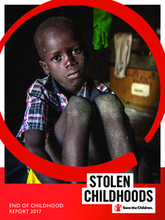Executive Summary
For at least 700 million children worldwide – and perhaps hundreds of millions more – childhood has ended too soon. The major reasons included poor health, conflict, extreme violence, child marriage, early pregnancy, malnutrition, exclusion from education and child labor.
When taken together, these factors have created a global childhood crisis of massive proportions. For nearly a century, Save the Children has been fi ghting to save children from poverty and discrimination. This new report – the first in an annual series – takes a hard look at the events that rob children of their childhoods. These “childhood enders” represent an assault on the future of children.
Childhood should be a safe time of life for growing, learning and playing. Every child deserves a childhood of love, care and protection so they can develop to their full potential. But this is not the experience for at least a quarter of our children worldwide.
The majority of these children live in disadvantaged communities in developing countries, where they have been bypassed by progress that has lifted up many of their peers. Many suffer from a toxic mix of poverty and discrimination – excluded because of who they are: a girl, a refugee, from an ethnic minority or a child with a disability. These threats to childhood are also present in high-income countries. All countries, rich and poor, can do a better job of ensuring every child enjoys the right to a childhood.
In commemoration of International Children’s Day, Save the Children is launching a unique index exploring the major reasons why childhood comes to an early end. The End of Childhood Index focuses on a set of lifechanging events that signal the disruption of childhood.
It ranks 172 countries based on where childhood is most intact and where it is most eroded. It shows which countries are succeeding, and failing, to provide conditions that nurture and protect their youngest citizens. The indicators used to measure the end of childhood are: under-5 mortality, malnutrition that stunts growth, out-of-school children, child labor, early marriage, adolescent births, displacement by confl ict and child homicide.
Which children survive or die, learn or don’t, are protected or harmed, is no accident. Lost childhoods are a result of choices that exclude particular groups of children by design or neglect. Millions of children have their childhoods cut short because of who they are and where they live.
There have been major gains for children in the last 25 years, but recent progress in fighting extreme poverty has often not reached those children who need it most – because of geography, gender, ethnicity, disability or because they are victims of conflict.
Children's experience of childhood is largely determined by the care and protection they receive, or fail to receive, from adults. Children have the right to survival, food and nutrition, health and shelter. They also have the right to be encouraged and educated, both formally and informally. And they have the right to live free from fear, safe from violence and protected from abuse and exploitation.
In 2015, world leaders gathered at the United Nations to make a bold commitment – to end poverty in all its forms by 2030 and protect the planet for future generations. Taken together, the Sustainable Development Goals they established envision a future in which all children enjoy their rights to health, education and protection – in short, their right to childhood.1 Crucially, signatories to the new agreement promised to ensure this would happen for all segments of society – regardless of income, geography, gender or identity. And they promised that those who are furthest behind – the most excluded in society – would be reached first.
This pledge to leave no one behind must be upheld. Only then will we realize its potential to transform the lives of millions of children across the world, guaranteeing every last child the childhood they deserve.
The full text of this report is also available on our website in Arabic.

